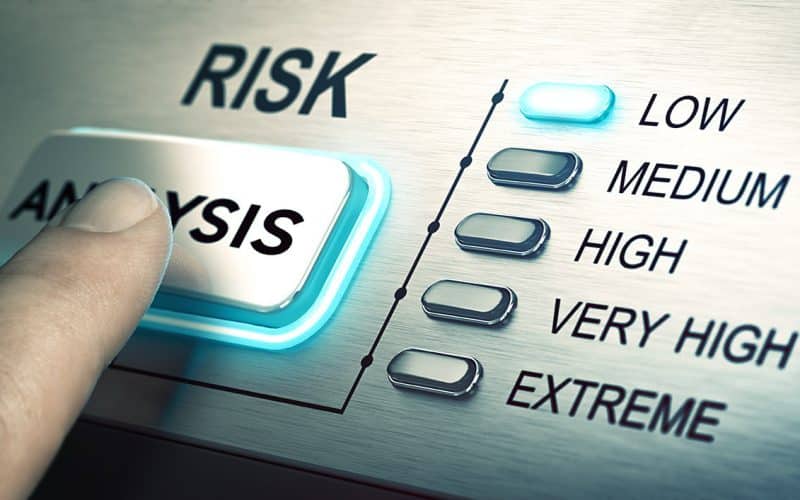The process of finding and assessing possible problems that may have a negative effect on key business strategies or programs is known as risk analysis. The aim of this procedure is to assist organizations in avoiding or mitigating risks. Over time, the benefits of risk analysis are endless—the most prominent being qualitative and quantitative.
Consider the probability of adverse events triggered by natural processes such as extreme weather, earthquakes, or floods, as well as adverse events caused by intentional or inadvertent human actions when conducting a risk analysis. Identifying the potential for harm from these incidents, as well as the probability that they will occur, is an important aspect of risk analysis.
For the most part, It is often a viable tool for businesses and other organizations to:
- Evaluate whether there is a balance between the potential risks of a project and its benefits. This is to help in the decision process when determining whether to move forward with the project;
- Predict and minimize the impact of negative outcomes from adverse events;
- Identify the effects of and prepare for changes in the business climate. This includes the possibility of new entrants coming into the market or changes in government regulatory policy; and
- Schedule responses to technological/infrastructural failure or loss from adverse events, irrespective of the cause.
Understanding Risk Analysis
In its simplest terms, risk analysis allows businesses, governments, and investors to determine the likelihood of a negative event affecting a company, economy, project, or investment. Furthermore, it is critical for assessing the value of a project or investment, as well as the best process(es) for mitigating such risks. Different approaches to risk analysis could be functional in evaluating the risk-reward tradeoff of a future investment opportunity.
The first step for a risk analyst is to figure out what could possibly go wrong. These drawbacks must be balanced against a probability parameter that determines the likelihood of an incident occurring.
It tries to predict the magnitude of the effect if the incident occurs. However, tons of risks, such as market risk, credit risk, and currency risk, can be mitigated by hedging or buying insurance.
Basically, almost all large companies necessitate some kind of risk analysis. Commercial banks, for example, must better hedge foreign exchange exposure on overseas loans. On the other, large department stores must account for the risk of lower profits as a result of a global recession. Furthermore, it’s crucial to understand that risk analysis helps professionals to recognize and minimize risks, but not fully eliminate them.
Risk Analysis Types
The two kinds of risk analysis out there namely, quantitative and qualitative analysis.
Risk Analysis (Quantitative)
A risk model is designed using simulation or deterministic statistics to assign numerical values to risk in quantitative risk analysis. Basically, a risk model is fed inputs that are mainly assumptions and random variables.
The model produces a variety of outputs or outcomes for any given set of inputs. So, risk managers use diagrams, scenario analysis, and/or sensitivity analysis to look at the performance of the model and decide how to minimize and deal with the risks.
A Monte Carlo simulation, for instance, can be beneficial in producing a number of different potential outcomes from a decision or action. Meanwhile, simulations are mathematical techniques that calculate outcomes for random input variables several times, each time with a different set of input values. The model’s final result, however, is a probability distribution of all possible outcomes, with the result of each input reported.
The results can be summarized using a distribution graph that includes indicators of central tendency such as the mean and median; as well as standard deviation and variance to determine the data’s variability.
Risk analysis methods like scenario analysis and sensitivity tables can also be used to determine the outcomes. Furthermore, any event’s best, middle, and worst outcomes are depicted in a scenario study. Separating the different results from best to worst provides a risk manager with a fair range of information.
Risk Analysis Example
For example, if the exchange rate of a few countries strengthens, an American company that operates on a global scale would want to know how it will affect its bottom line. A sensitivity table illustrates how results change when there’s an alteration in one or more random variables or expectations.
A portfolio manager might use a sensitivity table to determine how changes in the different values of each protection in a portfolio will affect the portfolio’s variance. Decision trees and break-even analysis are two other forms of risk management techniques.
Risk Analysis (Qualitative)
Qualitative risk analysis is an empirical approach that does not use numerical and quantitative scores to classify or assess risks. Alternatively, a written definition of the risks, an assessment of the magnitude of the impact (if the danger occurs), and countermeasure plans in the event of a negative event are all part of qualitative research.
Examples of this type of risk analysis include the following;
- SWOT analysis,
- Cause and effect diagrams, decision matrix, game theory, and other qualitative risk methods.
This means that somewhere along the line, a company that wants to assess the effect of a data breach on its servers would need a qualitative risk strategy to better compensate for any lost revenue that could result.
Value at Risk (VaR) [Example of risk analysis]
Value at risk (VaR) is a metric that calculates and quantifies the level of financial risk in a business; this also includes portfolios or positions over a given time period. Furthermore, investment and commercial banks use this metric to calculate the magnitude and frequency ratio of possible losses in their institutional portfolios. Some other vital uses include the following;
- VaR is a tool that risk managers use to assess and monitor risk exposure.
- It estimates help to assess individual positions or entire portfolios, as well as to assess firm-wide risk exposure.
VaR is calculated by shifting historical returns from worst to best with the expectation that returns will be replicated, especially in risky situations.
However, one thing to bear in mind is that VaR does not offer utter certainty to analysts. Rather, it’s a guess that hangs on certain probabilities.
Risk Analysis’ Limitations
- Risk is a probabilistic metric. This means that it never tells you exactly how much risk you’re open to at any point. It only tells you what the distribution of potential losses would be if and when they happen.
- There are no universally accepted methods for estimating and assessing risk. Even VaR can be approached in a variety of ways.
- Risk is often predicted to occur using standard distribution probabilities, which rarely occur in practice and are incapable of accounting for serious or “black swan” events.
The financial crisis of 2008, for example, revealed these flaws, as seemingly innocuous VaR estimates vastly underestimated the probability of risk events posed by subprime mortgage portfolios.
The size of the risk was also a subject of underestimation, resulting in subprime portfolios with extremely high leverage levels. As a result of the underestimation of the likelihood and severity of the risk, financial firms were unable to cover billions of dollars in losses as subprime mortgage prices fell significantly.
Risk Analysis Benefits
To effectively and efficiently protect their information assets, organizations must consider the risks that accompany the use of their information systems.
In a variety of ways, risk analysis can benefit a company in improving its protection. Organizations may use the findings of risk analyses, depending on the form and scope of the study, to:
- Identify, rate, and compare the overall financial and organizational effect of threats to the organization;
- Identify security vulnerabilities and decide the next steps to remove deficiencies and improve security;
- Improve coordination and decision-making processes in relation to data security;
- Improve information security policies and procedures. And to further establish cost-effective strategies for enforcing these policies and procedures;
- Enforce security measures to reduce the most significant risks;
- During the risk analysis process, highlight best practices to raise employee awareness of security measures and threats; and
- Consider the financial implications of possible security risks.
In the end, risk analysis, when done correctly, is a viable method for managing risk costs and assisting an organization’s decision-making process.
Steps in the risk assessment process
The following are the basic steps in the its process:
#1. Conduct a risk assessment survey:
The first phase in the risk analysis process, getting feedback from management and department heads, is crucial. This is a pretty good place to start when it comes to recording particular risks or threats in each department.
#2. Determine the dangers:
It is used to evaluate an IT system or another part of an enterprise. It goes deeper into asking questions like What are the risks to software, hardware, records, and IT employees? What are the potential negative consequences, such as human error, burning, floods, or earthquakes? What are the chances that the system’s integrity will be jeopardized or that it will be unavailable?
#3. Examine the dangers:
If the risks have been established, the risk analysis process should assess the probability of each risk occurring, as well as the risks associated effects. It should also include how they could impact the project’s objectives.
#4. Create a risk management strategy:
The risk analysis should generate control recommendations that could help to reduce, move, embrace, or avoid the risk. Obviously, these recommendations would be on the basis of an analysis of the assets; including which risks are likely to adversely affect those assets.
#5. Put the risk management strategy into action:
Oftentimes, the major aim of risk analysis is to put in place systems to eliminate or reduce risks. Hence, begin by resolving or at the very least mitigating each risk until it is no longer a threat.
#6. Keep an eye on the dangers:
Any risk mitigation approach should provide a continuous process of defining, treating, and managing risks.
However, depending on the type of risk analysis being in play, the emphasis of the analysis as well as the format of the findings will differ.
Risk analysis: qualitative vs. quantitative
The qualitative and quantitative approaches to analysis are the most common. Using predefined rating scales, qualitative analysis assesses the probability that a risk will arise purely on the basis of subjective characteristics and the effect it may have on an organization.
Risks are often classified into three levels: low, medium, and strong. The likelihood that a risk will occur can also be expressed or categorized as the probability that it will occur, varying from 0% to 100%.
Quantitative analysis, on the other hand, tries to assign a particular monetary value to adverse events. This indicates the possible cost to an entity if the occurrence happens, as well as the probability of the event occurring in a given year. In other words, if projections for a major cyberattack cost $10 million and the probability of the attack happening in the current year is 10%, the cost of that risk for the current year is $1 million.
Furthermore, since it collects data from participants in the risk analysis process based on their expectations of the likelihood of a risk and the risk’s possible effects, a qualitative risk analysis generates subjective results. This method of categorizing risks aids companies and/or project teams in determining which risks are low priority and which need active managing to minimize the impact on the company or project.
So, if a company conducts a quantitative risk analysis and then suffers a data breach, it should be able to quickly assess the financial effect of the incident on its operations.
The quantitative analysis offers more reliable knowledge and evidence to an enterprise than qualitative analysis, enhancing its usefulness in the decision-making process.
The Importance of Risk Analysis
It is used by businesses and other organizations to:
- to foresee and lessen the impact of unfavorable outcomes from unfavorable circumstances; In order to aid in the decision-making process while determining whether to carry forward with the project, consider whether the possible risks of the project are balanced by its advantages;
- prepare for technological or equipment failure or loss due to unfavorable circumstances, both natural and created by people; and
- determine the effects of and be ready for changes in the business environment, such as the possibility of new competitors joining the market or modifications to governmental regulatory policies.
What Is an Example of Risk Analysis?
Businesses may identify, measure, and prioritize any risks that could have a detrimental impact on their operations with the aid of an IT risk analysis. IT hazards can range from technological blunders and security lapses to infrastructure breakdowns and human error.
What Are the Three Risk Analysis?
Risk assessment, risk management, and risk communication are the three components that make up the process of risk analysis. Conducting a risk assessment in order to identify risks related to food safety is the first step in the risk analysis process.
How Risk Analysis Is Done?
- Here are the methods by which risk analysis is done
Determine the dangers. Make a list of the dangers you might face as a result of the course of action you are thinking about. - Define the various levels of uncertainty.
- Determine the effect of uncertainty.
- Finish up the risk analysis model.
- Analyze the outcomes.
- Activate Solution
What Are Risk Analysis Tools?
Risk matrices, decision trees, FMEAs, and bowtie models are the four most often used risk assessment methods. What-if analysis, failure tree analysis, and hazard operability analysis are some more methods of risk assessment.
What Is Risk Analysis Model?
The Project Risk Analysis Model (PRAM) uses Monte Carlo simulation to construct cost and schedule probability distributions from cost, schedule, risk, and uncertainty variables provided by the user. It generates quantitative risk analysis outputs that offer project managers and teams actionable information.
Why Is Risk Analysis Necessary?
A risk analysis identifies the internal and external risks associated with the proposed project in the application, rates the likelihood of the risks, rates the potential impact of the risks on the project, and identifies actions that could help mitigate the risks.
What Is the Basic Formula for Risk Analysis?
The chance of an event and its consequences are combined to form risk. In general, risk = likelihood x impact.
- Demand Management: Overview, Comparisons, Pros & Cons
- Strategic Risk Management: Overview, Plans, Implementation (+ Free tips)
- Risk manager: Salary, Job Description, Qualification (+Detailed Guide).
- Risk Management Strategies: 5+ Strategies You Can Follow Now!!!
- Demand Planning Softwares: Top 2023 Picks & Best Practices






